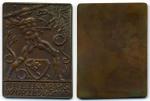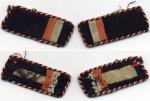
bolewts58
Active Contributor-
Posts
624 -
Joined
-
Last visited
-
Days Won
11
Content Type
Profiles
Forums
Blogs
Gallery
Events
Store
Everything posted by bolewts58
-
Do you mean a list of recipients? If so, I doubt that there was ever an accurate record of recipients for most Freikorps awards, given how Freikorps formed, merged and disbanded. I've only ever seen one award document for the SSVK medal. It belongs to Chris Boonzaier. I believe he's posted it here before.
-
No. You misunderstood what I said. I meant that some fakes are being manufactured in those places. But, they're being manufactured in Germany too as well as other countries. I didn't mean that collectors (like you) are selling fakes. I haven't encountered anything like that. But, in the case of crooks like the "Club". for example, I don't believe that they are directly making the fakes that they sell. I believe they're being made by others, likely outside Germany and sold by the "Club" and other spurious dealers. It's a long-held practice to use eastern European jewellers, largely because jewelers in eastern Europe still retain many of the old skills. Klietmann and Blass, for example had very finely-made Knight's Crosses (among other things) made in Hungary in the 1970s, and then passed these off as originals and largely got away with it because they had established-reputations. Then, there's Klietmann's collection of Godet dies, which he used to produce all manner of "authentic" stuff after 1945, which is why I get great amusement when the new breed of "expert" in Germany waxes poetic about this Godet piece or that, when there's a good chance that the piece is one of Klietmann's. Many long-time collectors know the truth about these two gentlemen, and their accomplices. Unfortunately, enough time has passed that their well-made fakes have now gone into 2nd and 3rd generation collections as genuine items. Fortunately, because of the Internet, it's far more difficult to pull off this type of major misrepresentation. But, there are still people out there, despite the warnings from forums like this, who are buying the fakes from the "Club" and other sellers, for example. As an aside, the interesting thing is that despite all the warnings about dealing with Russians (a lot of German eBay sellers won’t sell to them), it's Germans, who have given me the most grief as a collector, and the French, Belgians and Spanish who have caused the most problems for me as a seller on eBay. My Russian customers on eBay are among my best. They pay good prices and always pay on time. The French are among the worst. They bid and never pay. The most dishonest sellers I've encountered are Germans. They don't accept returns or give refunds and some are among the nastiest people I've ever encountered.
-
I'll add however, that the biggest sellers of Freikorps fakes are obviously German eBay sellers and the list of these keeps growing. As you will remember, I got stuck with the Würzburg Plakette, which i didn't like the moment I got it. Yet, the seller wouldn't take it back. I ended up selling it as a likely fake for less than half of what I paid. You have to agree, however that Alexander Chichikalov in Russia, whether you call them collectors copies or not is nevertheless reproducing many Freikorps awards.
-
WTH dude? Thanx a lot for good words, I'm coming exactly from Baltics and collecting Freikorps. And since I know only one other guy from Estonia with the same area of interest, I believe this addressed to us? Amazing. Would be nice to hear some comments. I can also add that the best books up to date about FK awards are written by Russian author Konstantin Nikolayev, and they really helped many people to get the right items for collection, while most of the crap sold on ebay (including the medal in this thread which has nothing to do with original medal even designwise) is coming from Germany. With best regards, "Those from the Baltic States" Hey. I believe it was you who told me on more than one occasion that the fakers of Freikorps badges were mainly in Latvia and Russia. If most of the Frekorps fakes are made in Germany, then I stand corrected. In any event, I wasn't damning all Russians or those from the Baltic for the actions of a few bad apples anymore than I would blame all Germans for fakes coming from there. I also agree about the books by Nikolayev, although I don't own them, yet. There are fakers of militaria everywhere, especially the US. But, I was always led to believe that Freikorps fakes mainly came from those 2 locals.
-
I just saw the medal for sale on eBay. The seller is one of the many aliases of the Ordensammler Club a very well known seller of fake Freikorps awards. Very little of what this guy sells is real and yet he has a rating of 100% on eBay - go figure. Andreas: Unfortunately, the Freikorps bar is not mine. It belongs to another member here. I just pulled it off another thread to show for comparison. I would kill to have it as genuine Freikorps medal bars are among the scarcest things to find in German collecting.
-
I believe it's a well-made fake possibly by Alexander Chichikalov, who makes a variety of Freikorps medals and badges as collector copies. Unfortunately, these then end up in the hands of unscrupulous sellers on eBay and other such places and are offered as genuine period pieces. The give-away on these is the aged finish, which is done chemically. Originals usually had a matt yellow-gilt finish that is quite durable. The fact that there's no trace of any finish on this is a big red flag, as far as i'm concerned. Others might have different opinions. But, for me, I'd give this a wide berth. By the way, the ribbon is wrong as well.
-
My condolences for your loss and also a loss to our history. Your comment about, "not teaching kids about this stuff" is unfortunately true. I'm a university professor and unbelievably had to explain to a 2nd year student the other day about who the Nazis and Adolph Hitler were. He hadn't heard of either. regards, Brian
-
Yes, I saw this one with the hollow back on WAF and Feldgrau. With the exception of this one, everyone of these I've seen (admittedly only in pictures) has been solid on the back. Below is a picture of the one Huesken has for sale which is almost identical to mine, which doesn't prove anything. It seems to be one of those pieces that few people have actually handled. Since the market isn't flooded with repros of these, I suppose I'll assume it's believable, unless proven otherwise. But, it is somewhat shoddy in its manufacture.
-
I just received this fairly rare Freikorps commemorative plaque and have some doubts. I've never had one in hand before, having only seen pictures. But, the detail seems a little rough and soft. I've compared it to one Huesken has and it seems similar. But, perhaps that one is doubtful as well. I've never heard of this being faked. But, as everything is at risk these days, anything is possible. Does anyone have an original to compare it with and does anyone have an informed opinion either positive or negative? I'd really appreciate some help. http://gmic.co.uk/uploads/monthly_02_2013/post-12700-0-34829400-1361622887.jpghttp://gmic.co.uk/uploads/monthly_02_2013/post-12700-0-13085800-1361622891.jpg
-
Schlesischer Adler / Silesian Eagles
bolewts58 replied to dond's topic in Germany: Weimar Republic & Deutsche Freikorps
Here it is. Beware of ones that say "für Schlesien". These are fake. It's believed that either they are the result of some stupid person removing the Polish inscription and replacing it with the German one Or, they are complete fabrications. -
I just picked up a group with a Loewenfeld Cross II class and on the reverse, the maker's name (Paul Küst) has been deliberately removed. Why I am posting this is because this is not an isolated case. I've seen other Loewenfeld Crosses, both 1st and 2nd class, with the maker's name removed in a similar way. Weitze had a 1st class with a similar defacing of the maker's mark, for sale last year. Other collectors with whom I have spoken have seen the same phenomenon on other crosses. Paul Küst was a prolific maker and supplier of awards, veteran's badges etc., including the Schlageter Shield. So, why is it that only some Loewenfeld Crosses have the maker name removed, but no other items from this firm? Does anyone here know why this was done?
-
Fake Freikorps von Epp Sleeve Badge
bolewts58 replied to bolewts58's topic in Germany: Weimar Republic & Deutsche Freikorps
Correction: In looking again at Robin's I realize the badge is the 1st type as well, but on the diamond with green cord worn on the SA uniform. The green chord denotes someone who was an original volunteer at the time the Freikorp was formed in 1919. -
Fake Freikorps von Epp Sleeve Badge
bolewts58 replied to bolewts58's topic in Germany: Weimar Republic & Deutsche Freikorps
Very nice 2nd type von Epp. Here's a correct 1st type with designer signature and '1919' around the rim. Guven the number of originals to compare that are accessible online, one wonders what kind of idiot would go ahead and pay so much for such an obvious piece of junk. -
This cast badge has been turning up quite often over the last year and seems to have fooled a lot of collectors and even some dealers (eMedals, for example). Sadly this one just sold for a staggering $263.88 on US eBay: too much even for a real one. It's such a poorly made cast to begin with, and made from some spurious white metal. I just don't understand what people are thinking. They were only ever made in oxidized bronze, were a hollow-back, stamped badge in 2 types only: one with designer signature and the year 1919 and a later one with no signature and no date worn as a tradition badge. This fake has become such a serious problem because this badge seems to be red hot among collectors in the US, for some reason. I hope the buyer sees this and sends the piece of crap back to the crook who sold it. The seller on eBay of this badge, who offers these and other fakes frequently is named deville68er.
-
I just picked this up and feel it is the same type of Stahlhelm specialist sleeve badge. I presume for former Jäger troops. Can anyone verify if this is indeed the same sort of badge? I know that a chart exists somewhere showing all of the scarce former service specialist badges. Does anyone have a copy of this chart? Any help would be appreciated.
-
I recently picked up these collar tabs. Although in shape and style they look like early SA collars, they don't match anything I can reference. I feel thay are most likely either early Stahlhelm, maybe for Bremen, or one the many paramilitary groups in the 1920s. It's also possible that they are some as yet unknown Freikorps. I just don't know and would appreciate any help.
-
If there was an opportunity for more bling on their vet tunics, they always went for it. However, genuine versions of this medal are extremely rare. Supposedly, there were only 600 of these given out. Oberland also had an even rarer award the "Adler des Tiroler Sturmzuges Oberland" - a Tirol Eagle in red enamel with a copper-gilt cartouche with "IM KAMPFE FÜR OBERSCHLESIEN" on its chest. The reverse was plain black lacquer. I had genuine examples of both of these 30 years ago. But, with the repros of the oval medal, I wouldn't bother to find a genuine one again - just too difficult.









